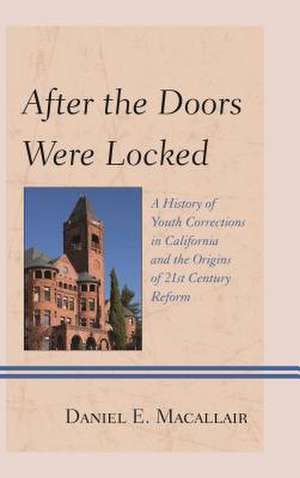After the Doors Were Locked
Autor Daniel E. Macallairen Limba Engleză Hardback – 29 oct 2015
Preț: 656.93 lei
Preț vechi: 853.16 lei
-23% Nou
Puncte Express: 985
Preț estimativ în valută:
125.74€ • 129.58$ • 106.15£
125.74€ • 129.58$ • 106.15£
Carte tipărită la comandă
Livrare economică 03-17 martie
Preluare comenzi: 021 569.72.76
Specificații
ISBN-13: 9781442246713
ISBN-10: 1442246715
Pagini: 350
Ilustrații: 7 black & white halftones, 2 charts, 12 tables, 1 graphs
Dimensiuni: 157 x 231 x 30 mm
Greutate: 0.68 kg
Editura: Rowman & Littlefield
ISBN-10: 1442246715
Pagini: 350
Ilustrații: 7 black & white halftones, 2 charts, 12 tables, 1 graphs
Dimensiuni: 157 x 231 x 30 mm
Greutate: 0.68 kg
Editura: Rowman & Littlefield
Notă biografică
Daniel E. Macallair is the Executive Director and co-founder of the Center on Juvenile and Criminal Justice. Macallair¿s expertise is in the development and analysis of youth and adult correctional policy. He has implemented model community corrections programs and incarceration alternatives throughout the country and is an expert on criminal justice reform. Macallair serves on the faculty of the Department of Criminal Justice Studies at San Francisco State University as a Practitioner-in-Residence, where he teaches courses on adult and juvenile corrections policy. He is also an author of numerous publications and an invited speaker at conferences and seminars throughout the country.
Cuprins
Foreword: Honorable Tom Ammiano, Former Chair, Assembly Public Safety Committee
California State Legislature
Preface: Tim Silard, President, Rosenberg Foundation
Acknowledgments
Introduction: Juvenile Justice in Historical Perspective by Randall G. Shelden
PART I: THE SAN FRANCISCO INDUSTRIAL SCHOOL AND THE ORIGINS OF YOUTH CORRECTIONS IN CALIFORNIA
1 The Industrial School¿s Historical Roots
2 The Founding of the San Francisco Industrial School
3 Reorganization and Reform
4 New Legal Procedures and Jurisprudence
5 New Approaches and the Birth of Probation
6 The Industrial School¿s Legacy
PART II: CALIFORNIA ENTERS THE REFORM SCHOOL ERA
7 The California State Penological Commission and the Search for New Approaches
8 Founding of the California Juvenile Court
9 The Whittier State School and the Realities of Institutional Life
10 The Introduction of Intelligence Testing at Whittier and the Emergence of Eugenics
11 Preston and the George Junior Republic Experiment
12 The Establishment of the California School for Girls
13 Preston in the 1920s and 1930s
14 California Commission on the Study of Problem Children and the Reaffirmation of Institutional Care
15 The 1930s: The Decade of Complacency and the End of an Era
PART III: FROM REFORM SCHOOL TO CORRECTIONAL SYSTEM: THE CREATION OF THE CALIFORNIA YOUTH AUTHORITY
16 The Death of Benny Moreno
17 The Death of Edward Leiva and the Lindsey Committee
18 The Lindsey Report: Pulling Back the Curtain on Institutional Care
19 The Birth of the California Youth Corrections Authority Act
20 Expansion into the 1950s
21 The Birth of Community Treatment
PART IV: THE YOUTH AUTHORITY¿S DECLINE AND FALL
22 Changing Politics of the 1970s and 1980s
23 The Path toward More Punitive Justice
24 The Commonweal Hearings
25 The Farrell Litigation and the End of the Youth Authority Era
26 Returning to the Past: Reviving the Doctrine of Institutional Care
PART V: CONCLUSION
Afterword: Chet P. Hewitt, President & CEO, Sierra Health Foundation
Descriere
After the Doors Were Locked offers a look at the history of youth corrections in California from its origins to the present day. Macallair comments on the practices and how they have evolved throughout the centuries. This book also looks at the reforms currently taking place in California prison systems today.





